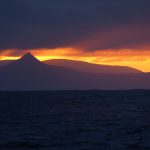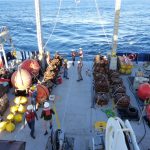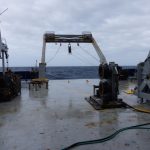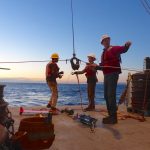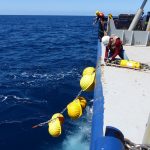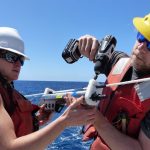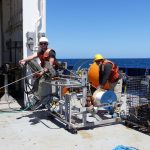We hit a huge milestone on Monday: we dropped mooring number 15, the last of our planned long-term moorings, as the sun set over the Tasmanian Landscape. All of the ingredients of the moorings—40 oversized spools of cable, 15 giant orange buoys, 50 thousand pounds of anchors, clusters of spherical glass balls enclosed in oversized yellow “hard hats,” and hundreds of shackles and links—all neatly and deliberately arranged on the deck when we left port on January 9th have disappeared. Tonight the rear deck is clear of gear.
The team’s plan to deploy 15 moorings in 10 days was a lofty one. But our hard-working mooring crew, led by Gunnar Voet (UCSD) and Eric Boget (APL-UW) and including all of the remaining scientists, pulled it off (I even participated by raising and lowering the A-frame—our main hoist to lift the heaviest items off the back deck). We strategically plunged more than 20 miles of line, dotted with 400 instruments, within meters of their targets more than two miles beneath the ship. These are all carefully calculated points on the ocean floor where the signals are anticipated to be the clearest
Everyone is thrilled that phase one is complete! But this doesn’t mean that our work is done. Now we move into a new phase of our operation—executing process experiments with our instrument-laden CTD/LADCP system (see next post!) to elucidate the physics that causes the breaking of these huge undersea waves. First stop—“the bump,” a small hill 1.5 miles below us where we think the shoaling waves are first feeling the influence of the deep submarine slopes of Tasmania, the southernmost state of Australia and the last piece of Gondwanaland to break off of the Australian continent.
Stay tuned.
—Julia Calderone, The Revelle
- Sunset over Tasmania. Credit: Jonathan Nash.
- Full rear deck at the beginning of the cruise. Credit: Julia Calderone.
- Empty deck after our last mooring on Monday. Credit: Julia Calderone.
- Gunnar Voet keeps track of all of the temperature sensors added to the mooring. Credit: Julia Calderone.
- Eric Boget directs an evening mooring deployment while John Mickett and Sam Fletcher prepare to add the next instrument to the line. Credit: Julia Calderone.
- Hardhats filled with glass spheres going over the side to provide buoyancy to the mooring. Credit: Julia Calderone.
- John Mickett helps an Acoustic Doppler Current Profiler (ADCP) into the water. An ADCP measures the direction and speed at which water is moving. Credit: Julia Calderone.
- June Marion and Jonathan Nash fashion a Microcat to the mooring line. This instrument measures water conductivity, temperature and depth. Credit: Julia Calderone.
- Sam Fletcher and Bob Hallberg spool and mark the mooring line before it is loaded up with instruments and fed into the ocean. Credit: Julia Calderone.
The Tasman Tidal Dissipation Experiment//Supported by the National Science Foundation

